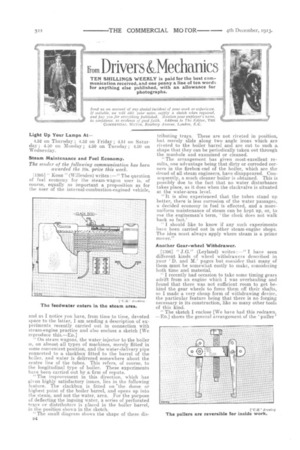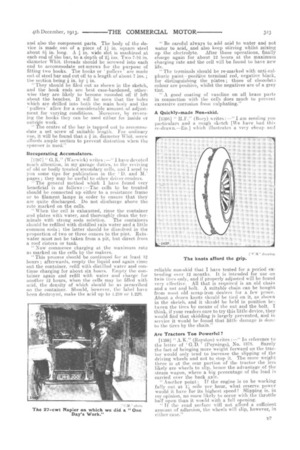Eom Drivers &Mechanics
Page 22

Page 23

If you've noticed an error in this article please click here to report it so we can fix it.
TEN SHILLINGS WEEKLY is paid for the best communication received, and one penny a line of ten words for anything else published, with an allowance for photographs.
Light Up Your Lamps At 4.52 on Thursday ; 4.52 on Friday ; 4.51 on Saturday; 4.50 on Monday ; 4.50 on Tuesday; 4.50 on
Wednesday.
Steam Maintenance and Fuel Economy.
The sender of the following communication has been awarded the 108. prize this week.
[1395] " Kosil " (Willesden) writes :—" The question of fuel economy for the steam-wagon user is, of course, equally as important a proposition as for the user of the internal-combustion-engined vehicle, and as I notice you have, from time to time, devoted space to the latter, I am sending a description of experiments recently carried out in connection with steam-engine practice and also enclose a sketch [We reproduce this.—Em] "On steam wagons, the water injector to the boiler is, on almost all types of machines, merely fitted in some convenient position, and the water-delivery pipe connected to a clackbox fitted to the barrel of the boiler, and water is delivered somewhere about the centre line of the tubes. This refers, of course, to the longitudinal type of boiler. These experiments have been carried out by a. firm of repute.
"The improvement in this direction, which has given highly satisfactory issues, lies in the following feature. The clackbox is fitted on "the dome or highest point of the boiler barrel, and opens up into the steam, and not. the water, area. For the purpose of deflecting the ingoing water, a, series of perforated trays or distributors is placed in the boiler barrel, in the position shown in the sketch.
"The small diagram shows the shape of these dise4
tributing trays. These are not riveted in position, but merely slide along two angle irons which are riveted to the boiler barrel and are cut to such a shape that they can be periodically taken out through the manhole and examined or cleaned.
"The arrangement has given most-excellent results, one advantage being that dirty or corroded corners in the firebox-end of the boiler, which are the dread of all steam engineers, have disappeared. Consequently, a much cleaner boiler is obtained. This is possibly due to the fact that no water disturbance takes place, as it does when the cla,ckvalve is situated at the water-area level.
"It is also experienced that the tubes stand up better, there is leas corrosion of the water passages, a decided economy in fuel is effected, and a moreuniform maintenance of steam can be kept up, or, to use the engineman's term, 'the clock does not walk back so fast.'
"I should like to know if any such experiments have been carried out in other steam-engine shops. The idea must always apply where steam is a prime mover."
Another Gear-wheel Withdrawer.
[1396] " J.G." (Leyland) writes :—" I have seen different kinds of wheel witledrawers described in your 'D. and M.' pages but consider that many of them must be somewhat costly to make, considering both time and material.
"I recently had occasion to take some timing gears adrift from an engine which I was overhauling and found that there was not sufficient room to get behind the gear wheels to force them off their shafts, so I made a very cheap form of withdrawing device, the particular feature being that there is no forging necessary in its construction, like so many other tools of this kind.
"The sketch I enclose [We have had this redrawn. —Em] shows the general arrangement of the puller'
arid also the component parts. The body of the device is made out of a piece of 1. in. square steel about Eq in. long. A in. wide slot is machined at each end of the bar, to a depth of 2 ills. Two 7-16 in. diameter Whit-. threads should be screwed into each end to accommodate set-screws for the purpose of fitting two hooks. The hooks or pullers ' are made out of steel bar and cut off to a length of about 7 ins.; the section being in. by in.
"They should be filed out as shown in the sketch, and the hook ends are best case-hardened, otherwise they are likely to become rounded off if left about the benches. It will be seen that the holes which are drilled into both. the main body and the pullers ' allow for a considerable amount of adjustment for varying conditions. Moreover, by reversing the hooks they can be used either for inside or ()Iasi& work.
" The centre of the bar is tapped oui to accommodate a set screw of suitable length. For ordinary use, it will be found that a in. diameter Whit. screw affords ample section to prevent distortion when the spanner is ased."
Recuperating Accumulators.
[1397] " G.K." (Warwick) writes :—" I have devoted much attention, in my garage duties, to the reviving of old or badly treated secondary cells, and I send to you some tips for publication in the '1). and M.' pages ; they may be useful to other driver-readers.
" The general method which I have found very beneficial is as follows : —The cells to be treated should be connected up either to a resistance frame or to filament lamps in order to ensure that they are quite discharged. Do not discharge above the rate marked on the cells.
" When the cell is exhausted, rinse the container and plates with water, and thoroughly clean the ter minals with strong soda solution. The containers should be refilled with distilled rain water and a little common soda; the latter should be dissolved in the proportion of two or three ounces to the pint. Rainwater must not be taken from a pit, but direct front a roof cistern or tank.
" Now commence charging at the maximum rate as marked on the cells by the makers.
"This process should be continued for at least 12 hours ; afterwards, empty the liquid and again rinse out the container, refill with distilled water and continue charging for about six hours. Empty the container again and refill with water and charge for another 12 hours, when the cells may be filled with acid, the density of which should be as prescribed on the container. Should, however, the label have been destroyed, make the acid up to 1.210 or 1.220. " Be careful always to add acid to water and not water to acid, and also keep stirring whilst mixing
up the electrolyte. After these operations, finally charge again for about 12 hours at the maximum charging rate and the cell will be found to have new "The terminals should be re-marked with anti-sul.phuric paint—positive terminal red, negative black, for distinguishing the plates ; those of ch000lat3 colour are positive, whilst the negatives are of a grey tint.
" A good coating of vaseline on all brass parts in connection with the cells does much to prevent excessive corrosion from sulphating."
A Quickly-made Non-skid.
[1398] " (Bury) writes :—" I am sending you particulars and a rough sketch [We have bad this re-drawn.—E] which illustrates a veTy cheap and reliable non-skid that I have tested for a _period extending over 12 months. It is intended for use on twin tires only, and if properly adjusted will be found very effective. All that is required is an old chain and a out and bolt. A suitable chain can be bought from most old scrap-iron dealers for a few pence. About a dozen knots should be tied on it, as shown in the sketch, and it should be held in position between the tires by means of the nut and the bolt. think, if your readers care to try this little device, they would find that skidding is largely prevented, and in service it would be found that little damage is dorm to the tires by the chain."
Are Tractors Too Powerful ?
[1399] " A.K." (Royston) writes In reference to
the letter of G.D. ' (Poynings), No. IV& Surely the fact of bringing more weight forward on the tractor would only tend to increase the slipping of the driving wheels and not to stop it. The more weight there is at the rear portion of the tractor the less likely are wheels to slip, hence the advantage of the steam wagon, where a big percentage of the load is carried over the back axle.
" Another point: If the engine is to be working fully out at V, mile per hour, what reserve power would it have for its highest speed? Slipping is, in my opinion, no more likely to occur with the throttle half open than it would with a full opening.
" If the roa-d surface will not afford a sufficient amount of adhesion, the wheels will slip, however, in either case."
























